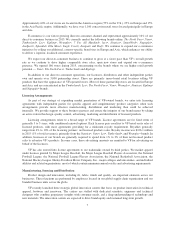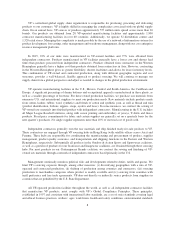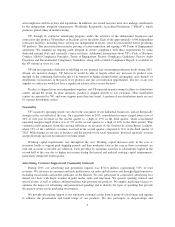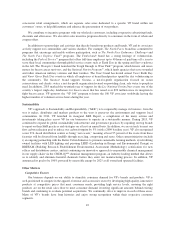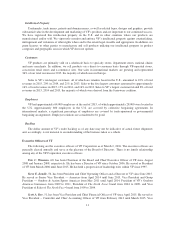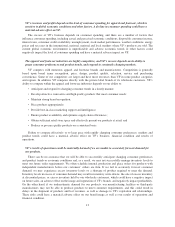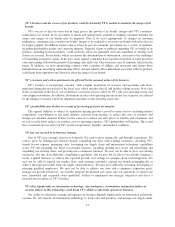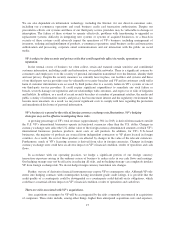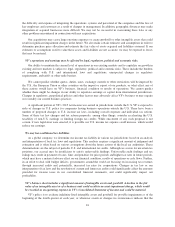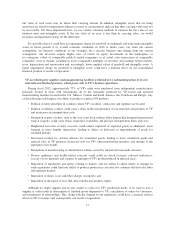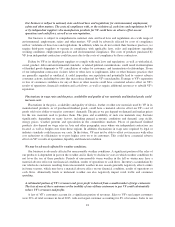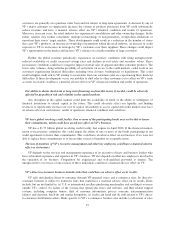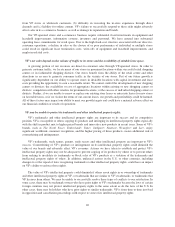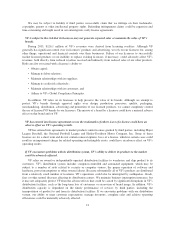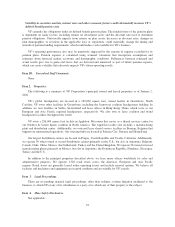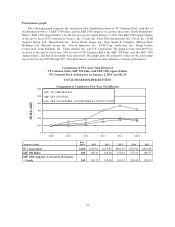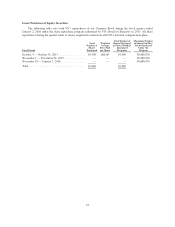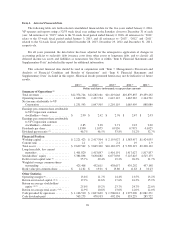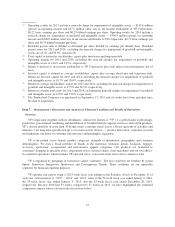North Face 2015 Annual Report Download - page 31
Download and view the complete annual report
Please find page 31 of the 2015 North Face annual report below. You can navigate through the pages in the report by either clicking on the pages listed below, or by using the keyword search tool below to find specific information within the annual report.fair value of such assets may be below their carrying amount. In addition, intangible assets that are being
amortized are tested for impairment whenever events or circumstances indicate that their carrying value may not
be recoverable. For these impairment tests, we use various valuation methods to estimate the fair value of our
business units and intangible assets. If the fair value of an asset is less than its carrying value, we would
recognize an impairment charge for the difference.
It is possible that we could have an impairment charge for goodwill or trademark and trade name intangible
assets in future periods if (i) overall economic conditions in 2016 or future years vary from our current
assumptions, (ii) business conditions or our strategies for a specific business unit change from our current
assumptions, (iii) investors require higher rates of return on equity investments in the marketplace or
(iv) enterprise values of comparable publicly traded companies, or of actual sales transactions of comparable
companies, were to decline, resulting in lower comparable multiples of revenues and earnings before interest,
taxes, depreciation and amortization and, accordingly, lower implied values of goodwill and intangible assets. A
future impairment charge for goodwill or intangible assets could have a material effect on our consolidated
financial position or results of operations.
VF uses third-party suppliers and manufacturing facilities worldwide for a substantial portion of its raw
materials and finished products, which poses risks to VF’s business operations.
During fiscal 2015, approximately 77% of VF’s units were purchased from independent manufacturers
primarily located in Asia, with substantially all of the remainder produced by VF-owned and operated
manufacturing facilities located in the U.S., Mexico, Central and South America, the Caribbean and Europe. Any
of the following could impact our ability to produce or deliver VF products:
• Political or labor instability in countries where VF’s facilities, contractors and suppliers are located;
• Political or military conflict could cause a delay in the transportation of raw materials and products to VF
and an increase in transportation costs;
• Disruption at ports of entry, such as the west coast dock workers labor dispute that disrupted international
trade at seaports, could cause delays in product availability and increase transportation times and costs;
• Heightened terrorism security concerns could subject imported or exported goods to additional, more
frequent or more lengthy inspections, leading to delays in deliveries or impoundment of goods for
extended periods;
• Decreased scrutiny by customs officials for counterfeit goods, leading to more counterfeit goods and
reduced sales of VF products, increased costs for VF’s anticounterfeiting measures and damage to the
reputation of its brands;
• Disruptions at manufacturing or distribution facilities caused by natural and man-made disasters;
• Disease epidemics and health-related concerns could result in closed factories, reduced workforces,
scarcity of raw materials and scrutiny or embargo of VF’s goods produced in infected areas;
• Imposition of regulations and quotas relating to imports and our ability to adjust timely to changes in
trade regulations could limit our ability to produce products in cost-effective countries that have the labor
and expertise needed;
• Imposition of duties, taxes and other charges on imports; and
• Imposition or the repeal of laws that affect intellectual property rights.
Although no single supplier and no one country is critical to VF’s production needs, if we were to lose a
supplier it could result in interruption of finished goods shipments to VF, cancellation of orders by customers,
and termination of relationships. This, along with the damage to our reputation, could have a material adverse
effect on VF’s revenues and, consequently, our results of operations.
17


